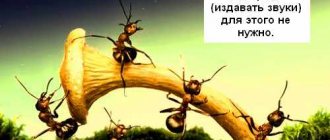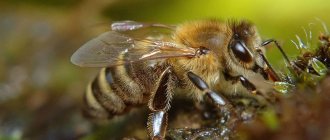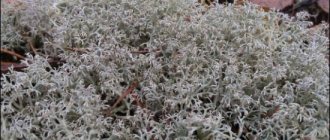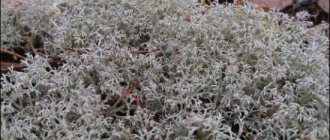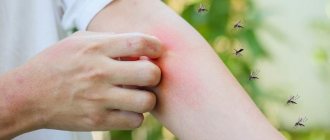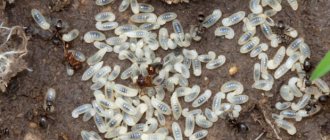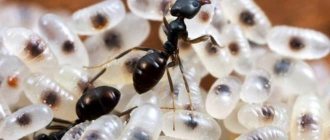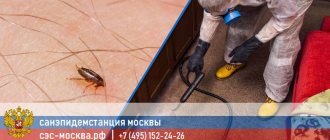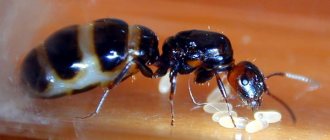This species is characterized by a domed anthill, the top layer of which consists of a ten-centimeter layer of sticks, needles, dry leaves, and pebbles. The ants constantly mix the nesting material so that the anthill does not begin to rot - this is a kind of forced ventilation.
The height of our anthill is 56 centimeters, diameter is 98 centimeters. The dome has 11 holes. The approximate population of the anthill is about 10 thousand individuals. Under the dome there are rim chambers in which eggs, larvae and pupae of ants are stored. Even deeper - a rotten stump or large branches. Under the ground at a depth of up to 1.5 meters there are interconnected chambers. The queen lives in one of them.
In an anthill there is a strict hierarchy and distribution of roles. The nest is controlled by the queen, the female who lays the eggs. Worker ants are also females, but they do not produce offspring as long as the queen is alive. The lifespan of a queen is 15-20 years, and that of a worker ant is up to 7 years. Males live only one season, do not participate in the life of the anthill and die immediately after mating.
In the immediate vicinity of the queen there is a retinue of 10 - 12 worker ants, they take care of her: they lick her and feed her. These are, as a rule, young ants, since all inhabitants of the nest go through an approximately month-long courtship stage with either the queen or the larvae. Then they move to the farthest section of the anthill’s patrol zone (its radius reaches 5-6 meters) and there they search for food - foraging. The ant passes the food it finds up the chain of command, and only from there is it distributed throughout the anthill. Along with food, the anthill is fed with a special pheromone - a substance secreted by the queen. It contains information about the health of the queen and the condition of the nest. The ants from the retinue lick this substance from the queen, carry it in a special crop and pass it on to each other along the chain. Thus, all individuals of the ant society are included in a single information space.
The anthill has its own system of punishments. For example, if a healthy foraging ant returns to the anthill with nothing several times in a row, it is “executed” - killed and allowed to forage itself. It is curious that ants act completely differently with those who have lost their ability to work as a result of injury. They are fed until they are able to ask for food, that is, tap their antennae on certain areas of the head of a healthy ant.
Ants are active predators, but at the same time they also keep “livestock”. Its role is played by aphids, and the ants eat not only the aphid itself, but also its secretions. This is not a form of parasitism, since without ant care, aphids die much earlier from other predators. Ants graze aphids on nearby plants and protect them. And at the first request, the aphids release excess nectar to them. To “milk” the aphid, the ant tickles its abdomen with its antennae.
Without harmful external influences, an anthill can live forever. But sometimes a small light brown beetle, the lamichouza, lands on the anthill. The bug penetrates the rim chamber, where the ant offspring are stored, and lays eggs there. To all the attempts of the inhabitants of the nest to deal with the stranger, he responds by secreting a special substance, which the ants immediately lick off and fall into a state of euphoria. Under the influence of this substance, they simply move aside and become quiet for a while.
This is how the death of the anthill begins.
Stages of Ant Development
An ant is an insect with complete metamorphosis (holometaboly). That is, in its development it goes through the following stages (see Figure 3-6):
Figure 3. The first stage of ant development is the egg.
Figure 4. The second stage of ant development is the pupa.
Figure 5. The third stage of ant development is the larva.
Figure 6. The fourth stage of ant development is the adult.
How to draw an Ant with a pencil step by step
Step 1.
Let's start the step with the base of the ant, do it as shown in my picture.
Step 2.
Let's outline the shape of the head and eyes.
Step 3.
Here we will draw an eye.
Step 4.
Draw the basic shape of the ant's jaw.
Step 5.
We draw a mustache for our ant and finish the jaw.
Step 6.
The next step is to draw the torso.
Step 7
We create the shape of the chest.
Step 8
Let's detail the chest.
Step 9
Now we draw the lower part of the ant.
Step 10
Let's detail this part.
Step 11
Here we outline the contours of the legs of our ant.
Step 12
Detailing the legs.
Step 13
Now all you have to do is draw the background.
Step 14
That's all. So we ended up with such an unusual ant. Thank you for being with us.
purmix.ru
Anthill structure
What do red forest ants build their home from?
There is enough building material in the forest. In red forest ants, the anthill is built from pieces of bark, twigs, needles, and soil. They are like janitors, they pull everything into one pile, which is why the forest becomes cleaner and the house grows before our eyes. This roof reliably protects insects from rain, snow, wind and heat.
Despite the external symmetry of the ant heap, it is not so inside: it is a complex network of labyrinths and chambers. Some of them go to a depth of 3-4 meters! Therefore, even a slight violation of the integrity of the above-ground part of the anthill (for example, if you stir the anthill with a stick) completely destroys the structure of the ant’s home, and it takes a lot of time to restore it.
Above the ground we only see a large pile, but what does the anthill look like inside?
The ant house is riddled with many passages and chambers, with most of it located underground (see Figure 7).
Figure 7. Internal structure of an anthill.
The anthill is covered with a layer of needles and twigs, it protects the home from the vicissitudes of the weather (see No. 1 in the figure).
At the very top of the anthill there is a “Solarium” - a chamber heated by the rays of the sun. In the spring, the inhabitants come here to warm themselves (see No. 2 in the picture).
There are several entrances to the anthill. They are guarded by soldiers and serve as ventilation ducts (see No. 3 in the picture).
There is also a “Cemetery” in the anthill. This is where worker ants include dead ants and garbage (see No. 4 in the figure).
When winter comes, the ants underground gather into a dense, motionless ball in the “Wintering Chamber” (see No. 5 in the picture). The temperature in the wintering chamber does not drop below +5. And in the spring, as soon as the sun warms up the dome of the anthill, the first scouts appear on its surface. Following them, the whole family comes to life.
Ants are very economical. They have a “Grain Barn” (see No. 6 in the picture), here the ants store grain; “Meat Pantry” (No. 10), where foragers bring caterpillars and other prey; “Cowshed” (No. 9), where ants contain aphids.
And the most protected place in the anthill, located, as a rule, underground is the “Royal Chamber” (No. 7), where the queen lives, laying up to one and a half thousand eggs a day and chambers with eggs, larvae and pupae (No. 8).
Up to one and a half million ants can live in such a structure, erected on an old stump.
An intricate system of passages and chambers allows insects to regulate the temperature and humidity inside the anthill. By closing or opening the ventilation holes, they create the necessary microclimate inside the entire structure.
Ants constantly move needles and twigs on the roof of the anthill, drying them, so there is no mold on the anthill. Ants keep their house clean, take out everything unnecessary and throw it in a landfill in a certain place.
Two tiers
If you study the structure of the anthill in the context of the description, you will notice that it is unevenly populated. It depends on the season. In summer, the upper layer (aboveground) is most densely populated, as well as the upper floors of the underground; they practically do not enter the lower ones (only occasionally to carry some of the supplies). During the cold season, everything changes. All supplies, as well as larvae and eggs, are transported deep underground. This allows the ants to avoid hypothermia - at a depth of 1-2 m it is always warmer than on the surface, where the temperature can drop to -30 degrees or even lower.
Professions of ants
In the anthill you can find both winged and wingless individuals. Males and females have wings only when they fly out of the nest during reproduction. Worker ants do not have wings, they are not capable of reproduction and are busy with various jobs. Each worker ant has its own “profession”. Usually the youngest become nannies, that is, they look after the brood. Having matured a little, they become builders, and then foragers (food earners). The oldest ants, which are not capable of obtaining food, become food store keepers, watchmen or observers. They do not run hunting, do not carry needles and twigs. Being on the anthill heap, they monitor what is happening around from there. The largest individuals protect the anthill from all kinds of attacks from the outside; they are called soldiers. Also, in the ant family there are necessarily “guardians” of nectar. They are needed in that unforeseen case if there is a famine in the anthill and the worker ants can no longer obtain food. The anthill also has its own hospitals, where doctors, for example, surgeons, work. And if one of their residents injured a limb, that is, an arm or a leg, then surgeons amputate it (gnaw it off).
Education
After the young female queen mates with several males on her first flight, she lands on the ground and tears off her wings. The queen then digs a nest and lays eggs there. The first workers, who soon emerge, begin to build a mound over the hole dug by the queen. The growth of the heap accelerates with the arrival of new workers and over time can reach a meter in height.
Some species, such as the blood-red slave ant (Formica sanguinea), found in Europe and parts of Asia, do not build their own anthills at all, and their fertilized queens invade the nests of some smaller ant species and displace the old queen. The workers of the host species care for the offspring of the alien queen as if they were their own, and soon all the workers of the host species disappear and the nest is taken over by another species.
Blood Red Slave Ant
Interesting facts about ants
Ants are the most numerous insects on Earth.
Ants have their own language, which scientists have not yet been able to decipher. However, they perfectly understand the signals, and instantly get involved in joint work when it comes to crossing natural barriers or mass gathering in an anthill to strengthen a home or save offspring during or before a disaster.
Ants have their own "pets". They are aphids. Shepherd ants graze it, the aphids secrete nectar, which the ants eat, and when the time comes, the aphids are eaten (see Figure 8). That is, everything happens the same as for a person who keeps cows or goats.
Figure 8. Herder ants and aphids.
Ants are heavyweights and hard workers: they lift loads approximately a hundred times heavier than their own weight, and are constantly engaged in socially useful work: preparing food, caring for offspring.
During heavy rains and floods, in order to save their queens and eggs, ants build bridges and rafts from their own bodies (see Figure 9). And this does not necessarily mean the death of the “building material” - an ant is able to spend four days under water without harm to health.
Figure 9. Ants crossing water.
Ants consume huge amounts of food; they are voracious and omnivorous. In one hundred days of summer, an anthill can destroy up to 2 million pests.
Scientists also suggest that ants may be able to count and regulate fertility, so that there are enough ants of each profession in the family. However, these assumptions have not yet been proven, but make us think about how little we know about the world around us.
Meet the ant city
“He plows like an ant!” - this is exactly what they say about the most hardworking people, who are ready to devote themselves to work around the clock, imagining a small insect in a hurry somewhere, dragging on fragile shoulders a real “log” about ten times larger than the worker himself.
Here stretches this living path of loaded ants, and towards them is another, already freed from the load in the house, hurrying for a new “portion”. And so from dawn to sunset. Have you ever seen such a path? Have you noticed the ant house?
It was only in appearance that it seemed to you like a heap of twigs, needles, pieces of earth and blades of grass. If you look inside, this is a real ant city, where life is in full swing.
Ants settle in huge colonies, the inhabitants of which live next to each other for many years. They can probably be called relatives. If we communicate using speech and gestures, then ants understand each other through the exchange of smells and food.
Each family has its own “amber”, therefore, by someone else’s incense, the “local population” immediately understands that a strange guest has entered the house. With the help of secreted pheromones, ants are able to communicate about food and danger.
The shape of the ant house in the form of a cone was chosen for a reason: raindrops roll down the walls of the anthill, without lingering on the surface and without leaking into the home. Little architects think about the location and height of their home, sufficient so that the sun's rays can penetrate through the “roof” and “walls”.
The seething life of ants is comparable, perhaps, to a parallel civilization, which has a hierarchy and a strict division of labor.
The benefits of ants for the forest
A large family has a rich farm - about a quarter of a hectare of forest along with trees standing on this site, a well-maintained network of roads and paths worn by ants.
It is necessary to clearly understand that colonies of these insects are an absolutely necessary part of the forest fauna; they perform many ecological functions. It’s not for nothing that ants are called forest nurses.
Ants are omnivores - they are universal predators and scavengers. Clouds of colorful and unimaginably diverse, sometimes completely unnoticeable creatures - larvae, weevils, leaf beetles, leaf rollers, hollows, scale insects, moths, sawflies, grinders - cut down the strength of the tree, paving the way for new detachments of forest destroyers. They are followed by bark beetles, pine beetles, longhorned beetles, and elephant beetles, and the weakened trees finally die. Forest ants, prowling in search of prey, when required, jointly attack the victim, gnaw with their sharp mandibles, spray with formic acid, suck out the corpse and drag it to the nest. The domes of anthills sometimes become completely green from hundreds of winter moth caterpillars collected from everywhere and abandoned here, and the ants continue to steal more and more prey. Prey of small size and weight is delivered to the anthill as a whole, large prey - in parts. Driven away by strong caterpillars, the ants often retreat, but later, when the victim, sprayed with acid, weakens, returns and resumes the attack. During the season, one large anthill of forest ants destroys up to 1 million insects.
Ants serve not only as a source of food necessary for the normal development of chicks, but also as “bird sanitary facilities”, in which birds, “bathing”, are cleansed of parasites (see Figure 10).
Figure 10. Anthill - bird “sanitary inspection room”
Many species of birds feed on ants: woodpeckers, wood grouse, black grouse. Hunters know that areas of the forest where anthills are frequent are abundant with game. During the spring food shortage, when there are still few other insects, small insectivorous birds, such as tits, feed on ants. Later they switch to feeding on other insects, mainly harmful ones.
By eating plant seeds, ants contribute to their spread - after all, they do not manage to drag all the prey to the anthill. They spread seeds of forest grasses, including sedge, bedstraw, chickweed, willow-herb, and violet. By enriching the forest grass cover, ants promote the proliferation of pollinating insects that feed on nectar and pollen of flowers. Ants sometimes themselves act as pollinators of flowers, as they also love to feast on nectar. Ants help improve soil fertility. They mix it, saturate it with oxygen (aerate) and loosen it to a depth of 50-70 cm, enrich it with organic substances, nitrogen, phosphorus, magnesium and potassium. Therefore, the anthills of red forest ants play the role of a “fertility factory”: grasses, shrubs and even trees growing near the anthill grow luxuriantly. The vegetation around anthills is characterized by intensive growth and bright green color.
Scientists have calculated the optimal number of anthills per unit area of forest: in pine forests this is 4 active anthills with a diameter of 1.3-1.5 m per hectare of forest, in oak forests - 6-7 nests. Accordingly, there should be even more smaller anthills.
That is why every anthill destroyed in the forest is a disguised time bomb. In fact, thousands of species of insects harm groves, forests, and oak forests. Six-legged pests suck juices from shoots, leaves, roots, disfigure them with swellings, growths, tumors, roll the leaves into a tube, entwine them with cobwebs, eat the pulp from the surface, skeletonize the leaves, leaving only a sparse network of veins, gnaw them from the edges, inside or whole , so that just the petiole reminds you: there was a leaf here! Otherwise there’s not even a petiole left! They destroy needles, penetrate under the bark on branches or trunks, drill wood from the outside, gnaw off roots, hide in the buds of future flowers, lay their deadly wormholes in leaves, bark, bast, wood...
Ant: description
The body of an ant consists of 3 main parts, clearly separated from each other - this is the head, which is connected to the chest and abdomen using a thin bridge in the form of a waist. All three parts are covered with a chitinous shell. The eyes of ants consist of a large number of lenses, but they do not allow you to get a good image, but only allow you to react to movement. On top of the head there are 3 additional simple eyes. With the help of 6 thin legs armed with claws at the end, ants are able to move on both horizontal and vertical surfaces. On the ant's head you can see antennae, which serve as organs of touch. With their help, insects detect odors, air fluctuations, and soil vibrations.
Ants mainly live by smell, since by smell they identify their relatives, determine the location of food, give danger signals, etc. Ants can secrete poison or formic acid, which allows them to defend against natural enemies. In addition, ants bite and it hurts very much.
The size of insects depends on the species, as well as on the functions that are intended for all members of the colonies. Therefore, their size ranges from 1 mm to 3 cm. It is characteristic of some species that the size of female individuals is larger than the size of working ants. Females grow wings, which disappear after the fertilization process. Different types of ants also differ in their color patterns. Therefore, there are ants of various colors.
TOP 10 INCREDIBLE FACTS ABOUT ANTS
Benefits of ants for human health
Ants are also important in medicine. The “poison” of red forest ants is formic acid, which is successfully used for various joint diseases, as an anti-inflammatory and analgesic. Ant venom contains antibiotics that effectively kill fungi and bacteria, including streptococci and staphylococci, the causative agents of typhoid, cholera, and tuberculosis.
Some people, as well as animals, use ant bites in “folk” methods of treatment (see Figure 11).
Figure 11. Traditional methods of treatment with formic acid.
Types of insects
The lifespan of the inhabitants of a colony is largely determined by their species.
- Pharaoh ants: workers - no more than 60 days, producers - 20 days.
- Tropical bulldog ants: workers - up to 5 years, queens - up to 20 years.
- The red wood ant is genetically predisposed to a five-year existence, but in nature it dies more often, becoming a victim of a bird of prey or an unfavorable environmental factor.
- Black garden ants can theoretically celebrate their third birthday, but in nature their lifespan is reduced to a year.
As we see, in real conditions, not all insects manage to live the genetically programmed number of years.
Ways to protect anthills
Red wood ants are included in the “Red List of Threatened Species” of the international Red Book of the World Conservation Union, as close to becoming a threatened species. Also included in some regional Red Books and lists of rare animals, for example, the Red Book of Moscow, the Red Book of the Voronezh Region. In the Chelyabinsk region, red forest ants are not only listed in the Red Book. In the Bredinsky district, the only myrmecological reserve in the Urals, “Bely Kolok,” was created to protect a large colony of red forest ants, which serves as a reserve of material for the resettlement of ants in the forests of the region.
It is necessary to take care of ants and, first of all, their homes - anthills. Where there are many visitors to the forest, forestry workers specially fence off anthills (see Figure 12).
Figure 12. An anthill fenced by foresters.
A person, even without directed sabotage, unwittingly causes harm to nature. This happens due to economic activity, during which forests are cut down and their inhabitants die.
Every year, the number of ant nests in the Moscow region decreases.
There must be at least one anthill per 1 hectare of forest. If it is not there, this section of the forest will die from pests, there will be no birds, and the trees will dry out.
Therefore, let's take care of the remaining pockets of untouched nature, because our lives directly depend on it.
What can we do to save ant nests:
- Don't burn old grass.
- Don't destroy anthills.
- Do not pollute the forest with garbage.
- Do not light a fire near an anthill.
- Fence and protect anthills.
- Together with adults, carry out work on the resettlement of ants.
- Explain the usefulness of ants.
Then all together we will save the Russian forest!
How to draw a Question Ant | ❤Lessdraw❤
In this lesson you will learn how to draw the Questioner ant. If you want to draw a Questioner along with a Turtle, then the lesson How to Draw a Wise Turtle will be useful to you. So let's start with simple shapes. You will need to draw three shapes: two droplet-like shapes and an elongated oval.
On the top droplet we draw the cap of the Questioner ant and antennae.
Erase the line under the cap, draw the eye and mouth of the ant just below.
Let's complete the Question with a pencil and draw four legs like this. Try to keep the lines neat.
You will also need to draw the lower legs of the ant in boots.
You need to draw a briefcase on the back of the Questioner ant. First we draw the shape of the backpack itself.
Now we add pockets and rivets to it.
Color the Questioner ant and add the Wise Turtle to the picture - it should turn out great.
Good luck with your creativity.
Similar lessons
www.lessdraw.com
Installation of information signs
My family and I really love nature, walking in the park and going to the forest in the suburbs of Noginsk, picking mushrooms and just riding a bike.
Unfortunately, based on the results of such walks, I had to come to the conclusion that the farther the forest is from the city and people, the more beautiful and lively it is.
Near roads, holiday villages, cities, the forest is different. It is darker, damper, there are more fallen trees, there is garbage, traces of fires. And there are no animals visible at all, few forest birds.
There are also almost no anthills near the city.
City park - no anthills found.
Forest "on Volkhonka" - no anthills found.
Forest in the vicinity of the Avtomobilist stadium - no anthills were found.
"Hazel" - no anthills found.
Forest in the area - no anthills found.
The closest place to the city where anthills were found is in the area of the street. Collective village Babenki.
My teacher, Zhanna Nikolaevna Goryainova, suggested making signs with information that ants need to be protected (see Figure 13), and installing these signs in the places where we find anthills.
Figure 13. Layout of a sign with information about the benefits and need to protect ants.
As a result, during October-November 2015, we installed three signs in the area of the villages of Babenki, Mamontovo and Timkovo, Noginsk district (see Figure 14-17).
Figure 14. Map of the location of installed signs in the suburbs of the city of Noginsk, Moscow region.
Figure 15. Photo of plate No. 3 (08.10.15, GPS coordinates 55°52'43.0″N 38°29'53.5″E)
Figure 16. Photo of plate No. 1 (11/08/15, GPS coordinates 55°55'8.19″N 38°36'10.17″E)
Figure 17. Photo of plate No. 2 (11/08/15, GPS coordinates 55°55'32.28″N 38°33'44.5″E)
We are not going to stop there. Seven more signs have already been prepared, which will be installed in the forests of the Noginsk region in 2016.
I hope that these signs will remind people that they need to take care of the surrounding nature, not destroy anthills, and will make them think about the fact that around us in the forest there is life in full swing, which we do not see, but without which the world around us will be completely different.
Various political and economic systems
Not everyone knows, but in different anthills - depending on the breed - there can be different economic and even political systems. This is not a joke at all. Scientists have repeatedly recorded real wars between anthills. Moreover, they are always provoked by certain species. They attack neighbors, partially destroy the guards in order to break into the premises with eggs and larvae. Then they drag them away, raising them in their own anthill as slaves - most of the work is done by the captured individuals while the owners continue their wars of conquest.
There are also cases of livestock farming. Ants really breed peculiar cows - aphids. In the mornings they drive her out of the anthill onto the leaves, protect her from ladybugs and other dangers, and in the evenings they return her back to the “stall”. For this they receive sweet milk, which causes so many problems for gardeners - because of it, the leaves die.
Finally, farmer ants can be seen. They chew small leaves, mixing them with fungal spores in their mouths, and then place them in special rooms where the mushrooms germinate and serve as food for the entire colony.
